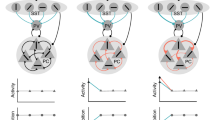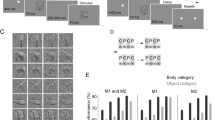Abstract
Recent experiments on behaving monkeys have shown that learning a visual categorization task makes the neurons in infero-temporal cortex (ITC) more selective to the task-relevant features of the stimuli (Sigala and Logothetis in Nature 415 318–320, 2002). We hypothesize that such a selectivity modulation emerges from the interaction between ITC and other cortical area, presumably the prefrontal cortex (PFC), where the previously learned stimulus categories are encoded. We propose a biologically inspired model of excitatory and inhibitory spiking neurons with plastic synapses, modified according to a reward based Hebbian learning rule, to explain the experimental results and test the validity of our hypothesis. We assume that the ITC neurons, receiving feature selective inputs, form stronger connections with the category specific neurons to which they are consistently associated in rewarded trials. After learning, the top-down influence of PFC neurons enhances the selectivity of the ITC neurons encoding the behaviorally relevant features of the stimuli, as observed in the experiments. We conclude that the perceptual representation in visual areas like ITC can be strongly affected by the interaction with other areas which are devoted to higher cognitive functions.
Similar content being viewed by others
References
Almeida R, Deco G, Stetter M (2004) Modular biased-competition and cooperation: a candidate mechanism for selective working memory. Eur J Neurosci 20:2789–2803
Amit DJ, Brunel N (1997a) Dynamics of a recurrent network of spiking neurons before and following learning. Netw Comput Neural Syst 8:373–404
Amit DJ, Brunel N (1997b) Model of global spontaneous activity and local structured (learned) delay activity during delay periods in cerebral cortex. Cereb Cortex 7:237–252
Amit J, Fusi S (1994) Dynamic learning in neural networks with material synapses. Neural Comput 6:957
Asaad WF, Rainer G, Miller EK (1998) Neural activity in the primate prefrontal cortex during associative learning. Neuron 21:1399–1407
Brunel N, Wang XJ (2001) Effects of neuromodulation in a cortical network model of object working memory dominated by recurrent inhibition. Comput Neurosci 11:63–85
Chelazzi L (1998) Serial attention mechanisms in visual search: a critical look at the evidence. Psychol Res 62:195–219
Chelazzi L, Miller E, Duncan J, Desimone R (1993) A neural basis for visual search in inferior temporal cortex. Nature 363:345–347
Corchs S, Stetter M, Deco G (2003) System-level neuronal modeling of visual attentional mechanisms. Neuroimage 20:143–160
Deco G, Rolls ET (2003) Attention and working memory: a dynamical model of neuronal activity in the prefrontal cortex. Eur J Neurosci 18(8):2374–2390
Deco G, Rolls ET, Horwitz B (2004) “What” and “Where” in visual working memory: a computational neurodynamical perspective for integrating fmri and single-neuron data. J Cogn Neurosci 16:683–701
Del Giudice P, Fusi S, Mattia M (2003) Modeling the formation of working memory with networks of integrate-and-fire neurons connected by plastic synapses. J Physiol Paris 97:659–681
Desimone R, Duncan J (1995) Neural mechanisms of selective visual attention. Annu Rev Neurosci 18:193–222
Fine J, Jacobs R (2002) Comparing perceptual learning across tasks: a review. J Vis 2:190–203
Freedman DJ, Riesenhuber M, Poggio T, Miller EK (2003) A comparison of primate prefrontal and inferior temporal cortices during visual categorization. J Neurosci 23:5235–5246
Fusi S (2002) Hebbian spike-driven synaptic plasticity for learning patterns of mean firing rates. Biol Cybern 87:459–470
Fusi S, Annunziato M, Badoni D, Salamon A, Amit D (2000) Spike-driven synaptic plasticity: theory, simulation, VLSI-implementation. Neural Comput 12:2227–2258
Fusi S, Asaad WF, Miller EK, Wang X-J (2005) Learning and forgetting visuo-motor associations in changing environment (submitted)
Goldstone R (1998) Perceptual learning. Annu Rev Psychol 49:585–612
Miller K (1994) A model for the development of simple cell receptive fields and orientation columns through activity-dependent competition between on- and off-center inputs. J Neurosci 14:409–441
Moran J, Desimone R (1985) Selective attention gates visual processing in the extrastriate cortex. Science 229:782–784
Reynolds J, Desimone R (1999) The role of neural mechanisms of attention in solving the binding problem. Neuron 24:19–29
Roelfsema P, Van Ooyen A (2005) Attention-gated reinforcement learning of internal representations for classification. Neural Comput 17(10):2176–2214
Rolls ET, Deco G (2002) Computational neuroscience of vision. Oxford University Press, Oxford
Seung H (2003) Learning in spiking neural networks by reinforcement of stochastic synaptic transmission. Neuron 40(6):1063–1073
Sigala N, Logothetis N (2002) Visual categorization shapes feature selectivity in the primate temporal cortex. Nature 415:318–320
Stetter M (2002) Exploration of cortical function. Kluwer, Dordrecht
Stetter M, Müller M, Lang EW (1994) Neural network model for the coordinated formation of orientation preference and orientation selectivity maps. Phys Rev E 50:4167–4181
Stetter M, Lang EW, Obermayer K (1998) Unspecific long-term potentiation can evoke functional segregation in a model of area 17. NeuroReport 9:2697–2702
Sutton RS, Barto AG (1998) Reinforcement learning: an introduction. MIT Press, Cambridge
Szabo M, Almeida R, Deco G, Stetter M (2004) Cooperation and biased competition model can explain attentional filtering in the prefrontal cortex. Eur J Neurosci 19(7):1969–1977
Szabo M, Almeida R, Deco G, Stetter M (2005) A neuronal model for the shaping of feature selectivity in IT by visual categorization. Neurocomputing 65–66:195–201
Tomita H, Ohbayashi M, Nakahara K, Hasegawa I, Miyashita Y (1999) Top-down signal from prefrontal cortex in executive control of memory retrieval. Nature 401:699–703
Wang X-J (2002) Probabilistic decision making by slow reverberation in cortical circuits. Neuron 36:955–968
Williams R (1992) Simple statistical gradient-following algorithms for connectionist reinforcement learning. Machine Learn 8:229–256
Author information
Authors and Affiliations
Corresponding author
Electronic supplementary material
Rights and permissions
About this article
Cite this article
Szabo, M., Stetter, M., Deco, G. et al. Learning to Attend: Modeling the Shaping of Selectivity in Infero-temporal Cortex in a Categorization Task. Biol Cybern 94, 351–365 (2006). https://doi.org/10.1007/s00422-006-0054-z
Received:
Accepted:
Published:
Issue Date:
DOI: https://doi.org/10.1007/s00422-006-0054-z




